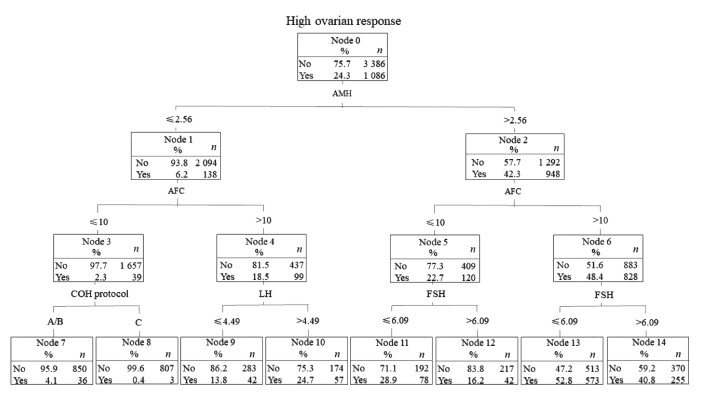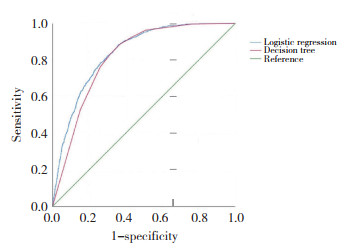文章信息
- 杜超, 侯开波, 关小川, 高艳, 孙凯旋, 于月新
- DU Chao, HOU Kaibo, GUAN Xiaochuan, GAO Yan, SUN Kaixuan, YU Yuexin
- 基于logistic回归模型和决策树模型分析辅助生殖患者卵巢高反应的影响因素
- Influencing factors of high ovarian response in assisted reproduction patients based on logistic regression and decision tree models
- 中国医科大学学报, 2022, 51(11): 998-1002
- Journal of China Medical University, 2022, 51(11): 998-1002
-
文章历史
- 收稿日期:2021-11-16
- 网络出版时间:2022-11-04 13:51
控制性超促排卵(controlled ovarian hyperstimulation,COH) [1]是辅助生殖技术中至关重要的一个步骤,其效果直接影响患者每个治疗周期的妊娠结局。患者行COH时,如果卵巢对外源性促性腺激素的刺激异常敏感,会导致过多的卵泡发育,此时称患者发生了卵巢高反应(high ovarian response,HOR) [2]。HOR会大大增加患者卵巢过度刺激综合征(ovarian hyperstimulation syndrome,OHSS) [3]的发生率,影响患者身体健康,同时对辅助生殖的治疗结局造成不利影响。
目前,HOR的影响因素分析主要采用logistic回归模型[4-5]。虽然logistic回归模型能够体现不同因素的影响效应,但是不能体现多因素间的交互作用,也难以直观地对临床决策提供帮助。近年来,决策树算法因具有易于理解和结构可视化等优点被广泛用于临床研究[6-7]。决策树能够通过根节点到每个叶子节点的路径直观地显示不同因素的重要程度,同时每条路径代表了不同因素作用下的分类结果,在一定程度上能够弥补单纯logistic回归模型的不足。本研究通过综合运用logistic回归模型和决策树模型分析HOR的影响因素,在比较二者优缺点的同时,也为临床决策和早期干预提供了新方法。
1 材料与方法 1.1 研究对象回顾性分析2015年1月至2020年12月于北部战区总医院生殖医学科行辅助生殖技术治疗的所有患者的临床资料,共纳入4 472个COH周期。纳入标准:(1) 于我院行COH助孕治疗;(2) 用药方案为长方案、改良长方案或拮抗剂方案;(3) 患者临床信息无缺失。排除标准:(1) 合并严重的甲状腺功能亢进、甲状腺功能减退、糖尿病等内分泌疾病者;(2) 采用其他用药方案治疗者;(3) 临床信息缺失或失访者。本研究获得我院伦理委员会批准,患者均知情同意。
1.2 研究方法收集患者临床信息,包括年龄、体质量指数(body mass index,BMI)、不孕类型、不孕时间、用药方案(长方案、改良长方案、拮抗剂方案)、基础窦卵泡数(antral follicle counting,AFC)、基础卵泡刺激素(follicle-stimulating hormone,FSH)、基础黄体生成素(luteinizing hormone,LH)、基础抗米勒管激素(anti-Müllerian hormone,AMH)、基础雌二醇(estradiol,E2) 等。
AFC的测量:于患者月经第3~5天通过经阴道超声测量双侧卵巢内卵泡(直径2~9 mm) 数量;基础激素水平测定:于患者月经第2~5天抽取外周血,检测患者FSH、LH、E2和AMH水平;用药方案选择:根据患者年龄、窦卵泡数和激素水平等信息,选择长方案、改良长方案或拮抗剂方案;HOR标准:当患者获卵数 > 15个或E2 > 18 300 pmol/L时,即诊断患者发生HOR[8]。
1.3 统计学分析 1.3.1 logistic回归模型的建立应用SPSS 26.0进行统计学分析。计量资料用x±s表示,采用t检验进行比较;计数资料用频数、百分比表示,采用χ2检验进行比较。筛选出组间有统计学差异的变量,P < 0.05为差异有统计学意义。利用LR向前法进行逐步回归分析,建立logistic回归模型,计算模型的受试者操作特征(receiver operating characteristic,ROC) 曲线的曲线下面积(area under curve,AUC)。
1.3.2 决策树模型的建立决策树是呈树形结构的分类和回归方法,由决策节点、分支和叶子组成,最上面的节点为根节点,每个分支是一个新的决策节点或者是树的叶子,代表一个测试输出,每个叶子节点代表一种可能的分类结果。本研究利用决策树中的CHAID算法,最大树深度设置为3层,父节点最小样本量设置为100,子节点最小样本量设置为50,拆分节点或合并类别显著性检验水平均为0.05,使用10倍交叉验证进行决策树计算效果的验证。最后将2种模型的AUC和预测效果进行比较分析。
2 结果 2.1 患者的一般资料共纳入4 472个COH周期。患者平均年龄(33.16±4.52) 岁,平均BMI (23.59±3.80) kg/m2,平均不孕年限(4.24±3.25) 年。其中原发性不孕患者2 321例(51.90%),继发性不孕患者2 151例(48.10%);促排卵采用长方案1 408例(31.48%),改良长方案1 691例(37.81%),拮抗剂方案1 373例(30.70%)。最终发生HOR 1 086例(24.28%),未发生HOR 3 386例(75.72%)。
2.2 促排卵治疗后发生HOR的单因素分析HOR组与非HOR组比较,AFC、AMH、年龄、FSH、LH、用药方案、不孕时间等有统计学差异(P < 0.05),E2、BMI、不孕类型无统计学差异(P > 0.05)。见表 1。
| Factor | High ovarian response group (n = 1 086) | Non-high ovarian response group (n = 3 386) | t/χ2 | P |
| AFC | 18.10±7.76 | 10.34±6.21 | 910.230 | < 0.001 |
| AMH (ng/mL) | 5.74±3.82 | 2.65±2.46 | 31.081 | < 0.001 |
| Age (year) | 30.94±3.56 | 33.87±4.56 | 19.429 | < 0.001 |
| FSH (mIU/mL) | 5.52±1.51 | 6.85±3.24 | 13.039 | < 0.001 |
| LH (mIU/mL) | 6.12±4.44 | 4.87±3.34 | 9.900 | < 0.001 |
| Infertility time (year) | 3.94±2.80 | 4.34±3.37 | 3.474 | 0.001 |
| BMI (kg/m2) | 23.36±3.79 | 23.67±3.80 | 0.763 | 0.406 |
| E2 (pg/mL) | 49.28±17.97 | 48.94±19.16 | 0.640 | 0.522 |
| COH protocol [n (%)] | 70.404 | < 0.001 | ||
| GnRH-a | 375 (26.63) | 1 033 (73.37) | ||
| Modified GnRH-a | 487 (28.80) | 1 204 (71.20) | ||
| GnRH-ant | 224 (16.31) | 1 149 (83.69) | ||
| Infertility type [n (%)] | 0.013 | 0.909 | ||
| Primary infertility | 562 (24.21) | 1 759 (75.79) | ||
| Secondary infertility | 524 (24.36) | 1 627 (75.64) | ||
| AFC,antral follicle counting;AMH,anti-Müllerian hormone;FSH,follicle-stimulating hormone;LH,luteinizing hormone;BMI,body mass index;E2,estradiol;COH,controlled ovarian hyperstimulation;GnRH,gonadotrophin releasing hormone;GnRH-a,GnRH-agonist;GnRH-ant,GnRH-antagonist. | ||||
2.3 HOR的logistic回归模型
将单因素分析中组间存在差异的因素作为自变量,以是否发生HOR作为因变量,进行二元logistic回归分析。结果发现,年龄(OR = 0.908,P < 0.001)、拮抗剂方案(OR = 0.664,P < 0.001) 和FSH (OR = 0.844,P < 0.001) 是HOR的保护因素,而LH (OR = 1.028,P = 0.024)、AMH (OR = 1.174,P < 0.001) 和AFC (OR = 1.104,P < 0.001) 是HOR的危险因素,见表 2。回归公式为
| Factor | β | SE | Wald χ2 | P | OR | 95%CI |
| Age | -0.097 | 0.011 | 71.242 | < 0.001 | 0.908 | 0.888-0.928 |
| COH protocol | 16.617 | < 0.001 | ||||
| Modified GnRH-a | -0.029 | 0.093 | 0.099 | 0.754 | 0.971 | 0.809-1.165 |
| GnRH-ant | -0.410 | 1.112 | 13.387 | < 0.001 | 0.664 | 0.533-0.827 |
| FSH | -0.170 | 0.024 | 51.509 | < 0.001 | 0.844 | 0.805-0.884 |
| LH | 0.027 | 0.012 | 5.084 | 0.024 | 1.028 | 1.004-1.052 |
| AMH | 0.161 | 0.017 | 84.743 | < 0.001 | 1.174 | 1.135-1.215 |
| AFC | 0.099 | 0.008 | 168.422 | < 0.001 | 1.104 | 1.088-1.121 |
| Constant | 3.172 | 0.474 | 44.884 | < 0.001 | 23.864 |
2.4 HOR的CHAID决策树模型
最终建立决策树共分为3层,包含8个终末节点,筛选出的影响因素主要包括AMH、AFC、用药方案、FSH和LH。其中AMH是决策树的根节点,说明AMH与发生HOR的关联性最强,应在临床决策时最优先考虑。次一级的影响因素为AFC,当AMH > 2.56同时AFC > 10个时,患者发生HOR的比例为48.4%。用药方案、FSH和LH位于决策树最底层,对于HOR的影响相对较弱。见图 1。

|
| 图 1 超促排卵后HOR影响因素的决策树分析 Fig.1 Decision tree analysis of factors affecting high ovarian response following controlled ovarian hyperstimulation |
2.5 logistic回归模型和CHAID决策树模型的AUC比较
绘制2种模型的ROC曲线(图 2),并计算AUC。结果发现,决策树模型和logistic回归模型的AUC分别为0.816和0.839,准确率分别为77.1%和79.8%,决策树模型的AUC和准确率略低于logistic回归模型。二者分类效果均为良好。见表 3。

|
| 图 2 logistic回归和决策树模型的ROC曲线 Fig.2 ROC curves of the logistic regression and decision tree models |
| Model | AUC | Standard error | P | 95% CI | Accuracy (%) |
| Logistic regression | 0.839 | 0.006 | < 0.001 | 0.826-0.851 | 79.8 |
| Decision tree | 0.816 | 0.006 | < 0.001 | 0.803-0.828 | 77.1 |
3 讨论
近年来,辅助生殖技术迎来飞速发展的契机,而正确评估卵巢反应性和储备功能在辅助生殖过程中具有重要价值。本研究通过logistic回归分析发现,年龄、FSH和拮抗剂方案是发生HOR的保护因素,而LH、AMH和AFC则是HOR的危险因素,与近年的研究[9]结果基本一致。目前普遍认为患者卵巢功能的减退与年龄的增长密切相关,RAEISSI等[10]发现不孕女性随着年龄的增加,出现FSH升高和AMH降低。因此,年龄增加可能影响体内激素水平,进而影响患者卵巢反应性。此外,拮抗剂方案的特点为促排卵时间短、促性腺激素用量少,因此发生HOR或OHSS的风险明显降低[11]。
决策树模型显示,AMH是影响HOR发生的最重要因素。AMH作为转化生长因子β超家族的成员之一,由卵巢皮质区小卵泡和窦前卵泡的颗粒细胞分泌,可以反映卵巢始基卵泡池的大小,是评估卵巢储备功能的有效标志物之一[12]。近年的研究也证实了AMH在HOR预测中的应用价值,贺玲等[13]对短效长方案下的患者进行研究,发现预测HOR的截点值为4.755 ng/mL,XU等[14]的回顾性队列研究发现预测HOR的AMH截点值为4.385 ng/mL。本研究中,决策树以2.56 ng/mL为AMH界值对患者进行了分类,这种差异可能是由于纳入患者标准以及促排卵方案不同。次一级影响因素为AFC,AFC是患者卵巢储备功能的最直观指标。刘红等[15]发现,AFC预测HOR的界值为15个。本研究中决策树模型显示,当患者AMH > 2.56 ng/mL且AFC > 10个时,约48.4%的患者发生HOR,说明此类患者应该引起临床医生的警觉。位于决策树最末节的因素分别为用药方案、FSH和LH,而年龄并未被纳入决策树中,其原因可能是年龄对患者的影响是多方面的,与AMH、AFC、FSH等因素存在密切的交互作用。
对2种模型进行比较,结果发现,logistic回归模型更侧重于不同影响因素与HOR发生的数量依存关系。如logistic回归分析显示,当患者年龄增加1岁时,发生HOR的概率为原来的0.908倍。此外,logistic回归模型与决策树模型相比具有更高的准确性和稳定性。决策树模型尽管在AUC方面存在轻微的差距,但其不仅能够体现自变量对因变量的重要程度,还能够将不同患者进行可视化分类,这有助于临床决策时优先考虑重要程度高的因素,直观的分类结果也更利于临床医生解读。
综上所述,本研究综合运用logistic回归模型和决策树模型对患者发生HOR的影响因素进行分析,在获得较高准确性的同时,结合2种模型的优点,为今后辅助生殖治疗过程中分析患者是否发生HOR提供了新思路。
| [1] |
DING XY, YANG JW, LI L, et al. Fertility outcomes in women after controlled ovarian stimulation with gonadotropin releasing hormone agonist long protocol: fresh versus frozen embryo transfer[J]. BMC Pregnancy Childbirth, 2021, 21(1): 207. DOI:10.1186/s12884-021-03698-5 |
| [2] |
AFLATOONIAN A, OSKOUIAN H, AHMADI S, et al. Prediction of high ovarian response to controlled ovarian hyperstimulation: anti-Müllerian hormone versus small antral follicle count (2-6 mm)[J]. J Assist Reprod Genet, 2009, 26(6): 319-325. DOI:10.1007/s10815-009-9319-5 |
| [3] |
NI YH, ZHANG HL, JIANG WW. Analysis and prediction of risk factors of ovarian hyperstimulation caused by long-acting GnRH agonist protocol in follicular phase[J]. Eur Rev Med Pharmacol Sci, 2022, 26(9): 3261-3268. DOI:10.26355/eurrev_202205_28744 |
| [4] |
柯张红, 孙艳, 刘丽荣, 等. 卵泡期长效长方案在符合卵巢高反应预测指标患者中的运用及其发生高反应的危险因素分析[J]. 中华生殖与避孕杂志, 2021, 41(3): 199-205. DOI:10.3760/cma.j.cn101441-20200315-00132 |
| [5] |
严思思, 丁锦丽, 杨菁. 抗米勒管激素水平对控制性促排卵患者的窦卵泡计数和卵巢反应性的预测价值[J]. 中国性科学, 2021, 30(6): 45-48. DOI:10.3969/j.issn.1672-1993.2021.06.015 |
| [6] |
ATIEH MA, PANG JK, LIAN K, et al. Predicting peri-implant di-sease: Chi-square automatic interaction detection (CHAID) decision tree analysis of risk indicators[J]. J Periodontol, 2019, 90(8): 834-846. DOI:10.1002/JPER.17-0501 |
| [7] |
PEI D, YANG T, ZHANG C. Estimation of diabetes in a high-risk adult Chinese population using J48 decision tree model[J]. Diabetes Metab Syndr Obes, 2020, 13: 4621-4630. DOI:10.2147/DMSO.S279329 |
| [8] |
乔杰, 马彩虹, 刘嘉茵, 等. 辅助生殖促排卵药物治疗专家共识[J]. 生殖与避孕, 2015, 35(4): 211-223. DOI:10.7669/j.issn.0253-357X.2015.04.0211 |
| [9] |
ZHOU SJ, ZHAO MJ, LI C, et al. The comparison of evaluative effectiveness between antral follicle count/age ratio and ovarian response prediction index for the ovarian reserve and response functions in infertile women[J]. Medicine, 2020, 99(36): e21979. DOI:10.1097/MD.0000000000021979 |
| [10] |
RAEISSI A, TORKI A, MORADI A, et al. Age-specific serum anti-Müllerian hormone and follicle stimulating hormone concentrations in infertile Iranian women[J]. Int J Fertil Steril, 2015, 9(1): 27-32. DOI:10.22074/ijfs.2015.4205 |
| [11] |
ZHANG W, XIE D, ZHANG H, et al. Cumulative live birth rates after the first ART cycle using flexible GnRH antagonist protocol vs. standard long GnRH agonist protocol: a retrospective cohort study in women of different ages and various ovarian reserve[J]. Front Endocrinol (Lausanne), 2020, 11: 287. DOI:10.3389/fendo.2020.00287 |
| [12] |
KOTANIDIS L, NIKOLETTOS K, PETOUSIS S, et al. The use of serum anti-Müllerian hormone (AMH) levels and antral follicle count (AFC) to predict the number of oocytes collected and availability of embryos for cryopreservation in IVF[J]. J Endocrinol Invest, 2016, 39(12): 1459-1464. DOI:10.1007/s40618-016-0521-x |
| [13] |
贺玲, 刘霓, 王婷, 等. 抗苗勒管激素和窦卵泡计数对卵巢功能正常患者卵巢反应性的预测价值[J]. 实用医学杂志, 2020, 36(4): 498-501. DOI:10.3969/j.issn.1006-5725.2020.04.016 |
| [14] |
XU H, ZENG L, YANG R, et al. Retrospective cohort study: AMH is the best ovarian reserve markers in predicting ovarian response but has unfavorable value in predicting clinical pregnancy in GnRH antagonist protocol[J]. Arch Gynecol Obstet, 2017, 295(3): 763-770. DOI:10.1007/s00404-016-4274-8 |
| [15] |
刘红, 李雪梅, 林碎玲, 等. 血清抗苗勒氏管激素在体外授精-胚胎移植中预测卵巢反应性[J]. 中国优生与遗传杂志, 2018, 26(7): 110-112. DOI:10.13404/j.cnki.cjbhh.2018.07.041 |
 2022, Vol. 51
2022, Vol. 51




